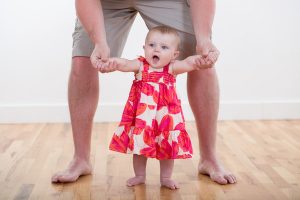 Your baby’s first steps are a thrilling moment, for you and for her! While you proudly film her toddling and toppling around the room, she relishes a new, more efficient way of getting where she wants to go.
Your baby’s first steps are a thrilling moment, for you and for her! While you proudly film her toddling and toppling around the room, she relishes a new, more efficient way of getting where she wants to go.
Highlights:
|
When Do Babies Walk?
Babies usually take their first unassisted steps around their first birthday, although the range is wide. Talk to your pediatrician if you’re worried about your baby’s development, but if she has steadily progressed through and mastered other gross motor milestones there’s generally no reason to worry if she takes her time transitioning to walking.
Why Do Babies Walk?
Walking is a difficult endeavor, so why would babies who have mastered getting around on their hands and knees want to abandon that stable position and take on the frightening task of traveling on just two feet? A study, published in the journal Psychological Science, compared established crawlers and new walkers and found that the walkers covered more distance, more quickly—suggesting that babies want to walk because they realize they can get where they want to go more efficiently.
How Does Walking Develop?
Pediatric Physical Therapist Dr. Andrea Hayward, PT, DPT says that walking is the reward at the end of a busy year of skill acquisition. During your baby’s first year her body went through incredible changes (head control, rolling, sitting, crawling, standing and cruising) that prepared her for walking by:
- Strengthening her bones and muscles.
- Building her sensory system so that she can achieve and maintain balance, as well as understand the relative position of her body parts and how to use them together for coordinated movement.
- Developing vision so that she can focus both near and far.
- Establishing the cognitive skill of motor planning, which allows her to plan and execute movements that help her safely navigate her environment, like stepping over or around toys in her path.
Walking and Gross & Fine Motor Development
“After babies move out of the skill acquisition stage, ages 1-3 are a stage of skill refinement,” says Hayward. “Gross motor movements become more fluid as children learn to move around their environment with ease.”
At first, your baby’s walking will be rigid and awkward. Her legs will be bowed and she’ll take stomping steps with stiff legs and outstretched arms—looking a little like Frankenstein! By the time she is about 3 years old, her legs will straighten out, her steps will become more graceful, and she will learn to place her heel on the floor first and then push off with her toes.
Being able to balance, shift weight, pivot, and step over objects shows how walking develops your baby’s foot-related fine-motor skills and prepares her for future milestones like running, jumping and climbing.
Walking and Feeding & Speech
As your baby’s movements become more complex with each new gross motor milestone, her oral muscles (responsible for feeding and speech) also become more coordinated. Walking brings in increased up-down, left-right, and side-to-side movements, which lead to a more controlled ability to bite and chew. This is your cue to introduce a variety of food textures, like harder vegetables, cubed fruits, cheese, and soft meats.
These more coordinated moments of the jaws, tongue and lips also allow her to make more complex speech sounds, and jargon will emerge as her babbling starts to sound like adult speech with her first true words sprinkled in.
How to Encourage Walking
- Don’t rush it! Remember, there’s a wide age-range for first steps. Unless you suspect a problem with her development, follow her lead and encourage her to walk when she’s ready. Crawling has many benefits that she won’t get once she’s upright!
- Explore our BabySparks program for fun, engaging walking activities you can do with your child.
- Allow plenty of time for practice. The same researchers mentioned above found that 12-19 month-old walkers took an average of 2,368 steps (traveling the length of 7.7 football fields) every hour! Amazing! This highlights the importance of giving your child as much time as possible to roam, unrestricted by strollers or other baby equipment. Experts warn that baby walkers in particular should be avoided, as they can delay development. The American Academy of Pediatrics also discourages their use, stating that they are unsafe.
- Keep her feet bare as much as possible. Your baby’s sensory system, which is responsible for balance and coordination, receives crucial information through her feet. What’s more, walking plays a big role in forming her still-developing feet, and shoes can interfere with optimal foot development if they’re poorly designed or worn too often.
- Expose her to different walking surfaces. Learning to walk on hard floors, grass, sand, mud, etc. can also boost balance and coordination.
If you thought keeping up with your crawling baby was tiring, get ready for a serious workout! As Hayward says, “Babies are driven by novelty.” This new way of getting around, more efficiently than ever, will thrill your tot and propel her into a new, even busier phase of exploring the world.








